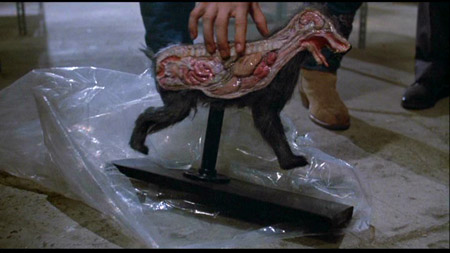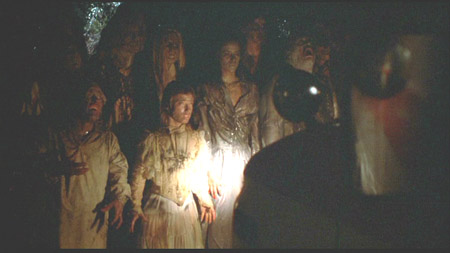In 1968, a relatively unknown filmmaker named George Romero made a little film called Night of the Living Dead. Though relatively low-budget, it became one of the earliest cult films and spawned an entire sub-genre of horror movies that continue to this day.

Romero wrote the screenplay with Night of the Living Dead with a fellow named John Russo. According to the film’s Wikipedia entry (which, in a refreshing change, cites most of its sources), the story grew from a horror comedy involving aliens into a straight, gruesome horror film that drew inspiration from Richard Matheson’s novel I Am Legend.
Romero went on to direct the even-better Dawn of the Dead, as well as Day of the Dead and the recent Land of the Dead. I’m not going to cite the Wikipedia entry for Return of the Living Dead, as it appears much less reliable, but allegedly Russo had different ideas about how to handle sequels to Night of the Living Dead and wanted to bring back the comic elements of the original concept. There was some legal tussling between Romero and Russo with the result that Romero got to use the “Dead” suffix, while Russo got “Living Dead.” The latter is a bit more iconic than just plain “Dead,” though it sounds a bit cheesier too, and “Dawn of the Dead” rolls off the tongue more than “Dawn of the Living Dead.”
In any event, the result of Russo’s dissent was Return of the Living Dead, a semi-sequel to Night of the Living Dead. The film is far more comic and campy than the Romero films, with none of the social commentary. It is often dismissed by zombie movie fans, but after watching it, I have to say I think it’s a relatively harmless and entertaining entry into the zombie flick canon. More to the point, it’s the film that introduced an important idea in the pop culture archetype of the zombie: a preference for brains.

From the beginning, when the owner of a cadaver warehouse, Frank (James Karen) shows his clueless young protegé Freddy (Thom Mathews) the “split dogs”—i.e., dogs that have been split in half, embalmed and mounted for classroom study purposes—it’s obvious this is going to be a fun, mindless film. Frank explains to Freddy that the movie Night of the Living Dead was based on an actual event that took place at a military hospital, and that one of the zombies from the incident was shipped to the warehouse by mistake. Why Frank or the warehouse owner, Burt (Clu Gulager) never bothered to contact the army about the mistake isn’t explained, but hey, I’m clearly overthinking my dumb zombie movie. Frank takes Freddy down to look at the zombie and, well, no points for guessing what happens next.
The film’s special effects are often cheesy, but it does have some of the best-looking zombies I’ve seen, including a fully animatronic, skeletal, and halved woman whose severed spinal column twists like a worm (my friend Kate and I debated whether we’d be able to control our spines like that; our guess was “no,” even had our spines been severed). The zombies are generally of a more monstrous, skeletal sort than the barely-made-up humans of the Romero films. They can even talk and even play tricks on their human prey, making them far more intelligent than a Romero zombie.
Most horrific is the “Tarman,” the original zombie from the incident that (according to the film) inspired Night of the Living Dead. Dressed in slimy rags, with eerily quick, jerky movements, the Tarman is one of the creepiest things I’ve seen in a zombie flick.
With the exception of Gulager’s Burt and his friend Ernie (ha, ha), an undertaker played by Don Calfa, the actors don’t have much to do but scream and get eaten. I feel obliged to note that Linnea Quigley, who plays a punk named “Trash” spends the majority of the movie completely naked. Yes, completely.

One plot point I found interesting was the explanation as to why the zombies preferred to eat brain matter. It seems that decomposing is very painful, and eating brains makes the pain go away. I guess the implication is that eating the endorphins in living brain matter provides zombie can get temporary relief from the pain. It’s hardly the social commentary of Romero, but it does add a certain touch of pathos to the zombie condition.
Return of the Living Dead was written and directed by Dan O’Bannon (best known as the screenwriter of Alien) based on a novel by Russo. O’Bannon seems to have been fully aware of the type of movie he was making and filmed accordingly. He gets some good gags in, especially one that shows why cremating a zombie might not be the ideal way to destroy it.
All in all, Return is worth seeing as a kind of addendum to Romero’s better zombie films. It’s the archetypal campy zombie flick, with enough inventiveness and fun to make it well worth the viewing. In fact, I suspect some people who aren’t diehard fans of the Romero films might enjoy this one more.
SEND MORE PARAMEDICS
Send more cops!
As I told you, I’ve seen/suffered through this movie twice. The first time it was fun. For me, it didn’t hold up to a repeat viewing, but I think I was pressured into it too soon by my girlfriend at the time.
That, and watching 17 minutes worth of trailers, all of which feature the “Do you want to party?” song is damaging to the brain.
I can see that. While I wouldn’t want to watch this film two weeks after having seen it, I think it could definitely stand up to yearly Halloween viewings, at least.
Of course, this from the guy who watches The Worst Witch and The Monster Squad every year…